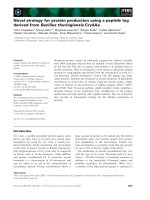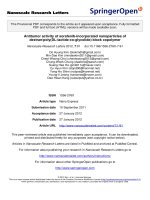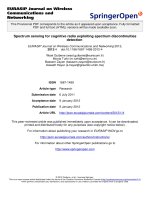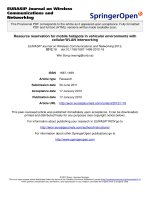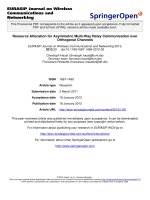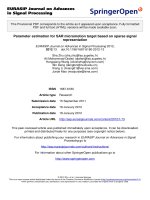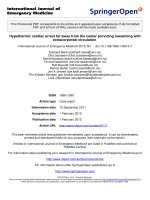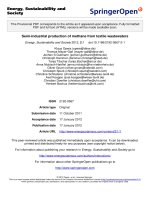Báo cáo toán học: " Biorefinery process for protein extraction from oriental mustard (Brassica juncea (L.) Czern.) using ethanol stillage" pdf
Bạn đang xem bản rút gọn của tài liệu. Xem và tải ngay bản đầy đủ của tài liệu tại đây (223.59 KB, 35 trang )
This Provisional PDF corresponds to the article as it appeared upon acceptance. Fully formatted
PDF and full text (HTML) versions will be made available soon.
Biorefinery process for protein extraction from oriental mustard (Brassica
juncea (L.) Czern.) using ethanol stillage
AMB Express 2012, 2:5 doi:10.1186/2191-0855-2-5
Kornsulee Ratanapariyanuch ()
Robert T Tyler ()
Youn Young Shim ()
Martin JT Reaney ()
ISSN 2191-0855
Article type Original
Submission date 5 January 2012
Acceptance date 12 January 2012
Publication date 12 January 2012
Article URL />This peer-reviewed article was published immediately upon acceptance. It can be downloaded,
printed and distributed freely for any purposes (see copyright notice below).
Articles in AMB Express are listed in PubMed and archived at PubMed Central.
For information about publishing your research in AMB Express go to
/>For information about other SpringerOpen publications go to
AMB Express
© 2012 Ratanapariyanuch et al. ; licensee Springer.
This is an open access article distributed under the terms of the Creative Commons Attribution License ( />which permits unrestricted use, distribution, and reproduction in any medium, provided the original work is properly cited.
1
Biorefinery process for protein extraction from
oriental mustard (Brassica juncea (L.) Czern.) using
ethanol stillage
Kornsulee Ratanapariyanuch
1
, Robert T. Tyler
1
, Youn Young Shim
2*
and
Martin J.T. Reaney
2*
1
Department of Food and Bioproduct Sciences, University of Saskatchewan, 51
Campus Drive, Saskatoon, SK S7N 5A8, Canada
2
Department of Plant Sciences, University of Saskatchewan, 51 Campus Drive,
Saskatoon, SK S7N 5A8, Canada
*Correspondence:
(YS), (MJTR)
KR:
RTT:
YS:
MJTR:
2
Abstract
Large volumes of treated process water are required for protein extraction. Evaporation
of this water contributes greatly to the energy consumed in enriching protein products.
Thin stillage remaining from ethanol production is available in large volumes and may
be suitable for extracting protein rich materials. In this work protein was extracted from
ground defatted oriental mustard (Brassica juncea (L.) Czern.) meal using thin stillage.
Protein extraction efficiency was studied at pHs between 7.6 and 10.4 and salt
concentrations between 3.4 × 10
−2
and 1.2 M. The optimum extraction efficiency was
pH 10.0 and 1.0 M NaCl. Napin and cruciferin were the most prevalent proteins in the
isolate. The isolate exhibited high in vitro digestibility (74.9 ± 0.80%) and lysine content
(5.2 ± 0.2 g/100 g of protein). No differences in the efficiency of extraction, SDS-PAGE
profile, digestibility, lysine availability, or amino acid composition were observed
between protein extracted with thin stillage and that extracted with NaCl solution. The
use of thin stillage, in lieu of water, for protein extraction would decrease the energy
requirements and waste disposal costs of the protein isolation and biofuel production
processes.
Keywords Biorefinery, Protein extraction, Thin stillage⋅
⋅⋅
⋅Mustard, Salt concentration,
Ethanol
3
Introduction
Brassica spp. oilseeds are grown throughout the world as sources of vegetable oil and protein-
rich animal feed (Henriksen et al. 2009). According to statistical data from the Canada Grains
Council (2011), the average annual production of Canadian canola over the period 2001−2010
was 9.2 million tonnes, and the Canadian oilseed crushing industry produced an average of 2.1
million tonnes of canola meal annually between 2001−2010. Commercial oilseed extraction may
include solvent extraction, mechanical expeller-press extraction, or combinations of mechanical
and solvent extraction to produce oil and meal. Canola meal is the portion remaining after
extraction of oil from canola seed and it is widely used as a protein source in poultry, swine,
beef, and dairy cattle feeds because of its excellent amino acid profile (Hickling 2011).
Thin stillage (TS) is a dilute stream of organic and inorganic compounds produced as a
coproduct of the ethanol industry. Usually, TS is processed by drying than added to distillers
dried grains (DDG) to produce DDG with solubles (DDGS). The latter is used in animal feeds. In
the manufacture of DDGS, TS is first concentrated into syrup before mixing with wet distillers
grains. TS drying consumes about 40−45% of the thermal energy and 30−40% of the electrical
energy utilized in a dry-grind facility (Wilkins et al. 2006).
The energy required to evaporate the
large amount of water entrained in TS is a major cost in the ethanol industry and contributes to
the poor lifecycle assessment of ethanol production (Bremer et al. 2010). To overcome the losses
in energy for this process several strategies have been proposed including feeding wet distiller’s
grains with solubles. This has the advantage of decreasing the cost of drying but necessitates
4
transporting water with the feed product to the animals. In addition the wet products may not be
suited for storage.
Production of protein isolates is equally inefficient. For examples, Newkirk et al. (2006)
disclose a multistage protein extraction and recovery process using water and CaO to adjust pH;
Diosady et al. (1989) extracted 100 g of rapeseed meal with 1,800 g of water; and Murray (1998)
extracted 50 kg of commercial canola meal with 500 L of water. In all of these extractions the
percent of protein concentrate recovered to water used in extraction and processing is less than
3%. Therefore, the consumption of large volumes of water, and its subsequent remediation are
costly barriers to the economic production of protein concentrates and isolates.
If the ethanol, oilseed, and protein processing plants are in close physically proximity, TS
from the ethanol production plant could be used directly as process water by the protein
processing facility. The ethanol producer would avoid the costs of evaporating and drying or
treating TS. The protein producer would not have to purchase water for the process and would
reduce the energy costs to heat the water for protein extraction. The oilseed processor would
provide defatted meal as raw material for protein extraction, and in the case of an oilseed plant
that also produces biodiesel, alkaline glycerol, a byproduct from biodiesel plants, could be used
for pH adjustment in the protein extraction process. Thus, the ethanol, biodiesel and protein
processes would benefit.
In a previous study (Ratanapariyanuch et al. 2011), we thoroughly characterized TS to
determine the presence of compounds that might affect protein extraction. The use of TS for
protein extraction from canola or mustard meal has not been reported previously. However, as
5
described above, the use of TS might offer several advantages in the extraction of protein from
oilseed meal.
Materials and methods
Materials, chemicals and reagents
Oriental mustard seed cultivar (B. juncea (L.) Czern. cv. AC Vulcan) seed was obtained from
Agriculture and Agri-Food Canada, Saskatoon Research Centre (Saskatoon, SK, Canada). All
seed was from the 2006 harvest and was grown on plots near Saskatoon. Pound-Maker
Agventures Ltd. (Lanigan, SK, Canada) provided TS from wheat. Samples of TS were stored at
4 °C for up to 4 months until used. TS samples were centrifuged at 1050×g for 20 min at 4 °C
(Model Avanti
®
J-E, Beckman Coulter Canada Inc., Mississauga, ON, Canada). Glycerol
containing approximately 10% KOH was provided by an industrial biodiesel processor (Milligan
Biotechnology Inc., Foam Lake, SK, Canada). Reagents and chemicals, unless otherwise noted,
were purchased from Sigma-Aldrich (St. Louis, MO, USA).
Defatted meal preparation
Mustard seed was extracted mechanically using a continuous screw expeller (Komet, Type CA59
C; IBG Monforts Oekotec GmbH & Co. KG, Mönchengladbach, Germany) with a 6 mm choke
and operating with a screw speed of 93 rpm. Oil remaining in the press-cake was removed using
hexane as a solvent (Milanova et al. 2006; Oomah et al. 2006) and the residual hexane in the
defatted meal was removed in a fume hood overnight.
Protein content
6
Protein content of mustard seed and fractions were determined by the Kjeldahl method as
modified by AOAC method 981.10 (AOAC 1990). Mustard seed and defatted meal samples (0.5
g) were digested by heating with concentrated H
2
SO
4
in a heating/digestion block using a
package of Kjeldahl digestion mixture 200 (VWR Scientific, Mississauga, ON, Canada) as a
catalyst. After digestion, samples were distilled using a steam distillation unit (Büchi Analytical
Inc., New Castle, DE, USA) with 30% (w/v) NaOH. Boric acid (4%) was used to trap ammonia
from the distillation. The distillate was titrated with 0.2 N HCl using an N-Point indicator
(Titristar N point indicator, EMD Chemicals Inc., Gibbstown, NJ, USA). Nitrogen concentration
(N in %) was used to estimate protein concentration (%) by means of a nitrogen-to-protein
conversion factor 5.7 (Sosulski et al. 1990) for TS and 5.5 (Lindeboom and Wanasundara 2007)
for mustard seed, meal, and protein.
Oil content
The oil content was determined using a Goldfisch Extractor (Model 22166B, Labconco Corp.,
Kansas City, MO, USA) according to AOAC method 960.39 (AOAC 1990). Samples (20 g)
were ground for 30 s in a coffee grinder to pass through a 1 mm screen. A portion of the ground
sample (3 g) was weighed on a filter paper (Whatman No. 4), which was then folded. The
samples were placed in cellulose thimbles (25 mm × 80 mm, Ahlstrom AT, Holly Spring, PA,
USA) and extracted for 6 h with hexane (50 ml). The hexane was distilled from the oil extraction
beakers, after which the beakers were heated at low temperatures (30−40 °C) using a hot plate
placed in a fume hood. The beakers were then transferred to an oven (105 °C) for 30 min and
then allowed to cool to room temperature (25 °C) in a desiccator.
7
Moisture content
The moisture content of mustard seed and defatted meal was determined according to AOAC
method 950.46 (AOAC 1990) using a Mettler Toledo halogen moisture analyzer (Model HB43,
Columbus, OH, USA), which employed a quartz heater to dry samples of material (1.0 g) at 105
°C until the mass varied less than ± 0.001 g over a 30 s. The samples were allowed to cool to
room temperature in a desiccator for at least 1 h before weighing. Selected samples were frozen
at −20 °C and lyophilized for 48 h.
The effects of pH and salt on protein extraction
The amount of liquid used for protein extraction may determine both extraction efficiency and
economics. A 1:30 ratio of defatted meal to solvent, and an extraction time of 120 min were
utilized in this study, as recommended by Diosady et al. (2005). To avoid protein precipitation
and achieve the maximum protein extraction, it is important to avoid pH near the isoelectric
point of protein. Based on the literature, the isoelectric precipitation of B. juncea protein has
been found to occur at approximately pH 6.0 (Moure et al. 2006). Therefore, alkaline conditions
(pH > 7.0) were chosen to study protein extraction. Ground defatted meal (5.0 g) was mixed with
150 ml of centrifuged TS. The pH of the system was adjusted to pH 7.6−10.4 using alkaline
glycerol from a biodiesel plant (~10% KOH) or 1.0 N HCl. NaCl was used to adjust the ionic
strength of the centrifuged TS. The concentrations of NaCl ranged from 3.4 × 10
−2
M
to 1.2 M.
The pH and salt concentrations employed are provided in Table 1.
The mustard meal-TS mixture was stirred continuously for 2 h at room temperature (25 °C).
After stirring, the solution was centrifuged at 10,000 rpm for 10 min at 4 °C to remove
8
suspended solids. The supernatant was freeze-dried, after which the protein content of the freeze-
dried protein of the undissolved solids were analyzed. The moisture content of the undissolved
solids was also determined. The conditions that provided the maximum protein extraction
efficiency in this study (NaCl concentration of 1.0 M and pH 10.0) were used in subsequent
studies of the effects of TS constituents on protein extraction efficiency. A control extraction
with an alkaline NaCl solution (1.0 M NaCl in deionized water, pH 10.0), hereafter termed NaCl
solution, was conducted. The quality of the protein products from the control and TS extractions
was compared.
Thin stillage composition
The composition of TS was characterized according to Ratanapariyanuch et al. (2011). Nuclear
magnetic resonance and high-performance liquid chromatography (HPLC) were utilized to
determine the content of organic compounds including ion chromatography and inductively
coupled plasma mass spectroscopy (ICP-MS) provided a detailed analysis of inorganic
constituents.
Protein extraction efficiency
Protein was removed from TS via ultrafiltration prior to its use for protein extraction from
mustard meal. Centrifuged TS was filtered through a 3,000 MWCO regenerated cellulose
membrane (Millipore Corp., Bedford, MA, USA) using a stirred ultrafiltration cell (Millipore
Corp., Bedford, MA, USA), running at 55 psi with a shear rate of 200 rpm. A solution of NaCl
(1.0 M and a pH of 10.0) was selected to obtain the highest protein extraction efficiency (based
on results from the previous experiment above). Protein was extracted as described above. The
9
supernatant from the centrifuged protein solution was dialyzed using Spectra/Por molecular-
porous membrane tubing (3,500 MWCO, Spectrum Laboratories Inc., Rancho Dominguez, CA,
USA) at a supernatant to deionized distilled water ratio of 1:1,000. Water exchange with fresh
deionised water was repeated three times a day until the conductivity of permeate water was
equal to that of deionised distilled water after 8 h of dialysis. The protein solution obtained by
dialysis was freeze-dried. Freeze-dried protein and undissolved solids were analyzed for protein
content, and the moisture content of undissolved solids was also determined. Protein products
from TS and NaCl extraction were pooled according to extraction solution type, and then
analyzed to determine the molecular weight, peptide sequence, amino acid composition,
digestibility, and lysine availability of the proteins.
Molecular weight
Molecular weights of the extracted proteins were determined by electrophoresis separation using
sodium dodecyl sulfate-polyacrylamide gel electrophoresis (SDS-PAGE) (Laemmli, 1970). Ten
micrograms of protein from TS or NaCl extraction and 5.0 µg of SeeBlue
®
Plus2 Pre-Stained
Standard (Invitrogen, Carlsbad, CA, USA) with a range of 4−250 kDa were applied onto 8.6 cm
× 6.8 cm Ready Gels (Tris-HCl 4−15%, 10 wells, Bio-Rad Laboratories, Hercules, CA, USA).
Each of the proteins products was mixed at a 1:1 ratio with loading buffer (1.0 M Tris-HCl, pH
6.8, containing 20% glycerol, 10% SDS, 0.4% bromophenol blue), and heated on a Gene Amp
PCR System 9700 (Applied Biosystems, Foster City, CA, USA) at 95 °C for 5 min. The Mini-
PROTEAN 3 cell (Bio-Rad Laboratories, Hercules, CA, USA) was filled with running buffer
(Tris base 3.028 g/l, glycine 14.414 g/l, SDS 1.0 g/l) adjusted pH to 8.3, and electrophoresis was
10
performed for 30 min at 50 V. The voltage was then increased to 100 V for 70 min. After
electrophoresis, the gels were stained with 0.1% of Coomassie Brilliant Blue R-250 (Sigma, St.
Louis, MO, USA) mixed with 40% methanol and 10% acetic acid. Subsequently the stained gels
were destained with 40% methanol and 10% acetic acid to remove the background.
Peptide mass fingerprinting
Each of the stained protein containing bands observed in the electrophoresis gel was excised
from reference gels for identification by matrix-assisted laser desorption ionization time-of-flight
mass spectrometry (MALDI-TOF MS) according to the method of Aluko et al. (2004). After
MALDI-TOF analysis of tryptic peptides, mass tags were searched against the mustard UniGene
database using the MS-FIT program of Protein Prospector (University of California, San
Francisco, CA, USA) with autocatalytic trypsin fragments as internal calibration standards. All
searches were performed against the National Center for Biotechnology Information (NCBI)
mustard UniGene database.
Amino acid composition
The amino acid profiles of extracted proteins were determined using the method of Llames and
Fontaine (1994). Performic acid and HCl were used to oxidize and hydrolyze the proteins,
respectively. Hydrolysates were analyzed for amino acids using an analytical ion exchange
column (AA911, Transgenomics Inc., Omaha, NE, USA) and post column derivitization with
ortho-phthaldialdehyde (OPA). An Agilent 1100 series HPLC system (Agilent Technologies,
Waldbronn, Germany) and fluorescence detector (RF-551, Shimadzu Scientific Instruments,
Columbia, MD, USA) were employed. Amino acids were quantified with the internal standard
11
method of measuring the absorption of reaction products with ninhydrin at 570 nm. Tryptophan
was determined by HPLC with fluorescence detection (extinction 280 nm, emission 356 nm)
after alkaline hydrolysis with barium hydroxide octahydrate for 20 h at 110 °C (European
Commission 2000). Tyrosine was not determined. Supplemented amino acid was determined by
extraction with 0.1 N HCl (European Commission 1998).
In vitro digestibility
The digestibility of extracted protein was determined using the multi-enzyme technique of Hsu et
al. (1977).
Lyophilized protein samples extracted with TS and NaCl solution were dissolved in
deionized water (6.25 mg protein/ml). The protein solutions (25 ml) were adjusted to pH 8.0 with
0.1 N HCl or NaOH, while stirring at 37 °C in a water bath. The multi-enzyme solution (1.6
mg/ml trypsin, 3.1 mg/ml chymotrypsin, and 1.3 mg/ml peptidase) was prepared in water
adjusted to pH 8.0 and stored in an ice bath. Digestions were conducted by adding the multi-
enzyme solution (2.5 ml) to 25 ml of protein solution while stirring at 37 °C. The pH of the
protein solution was recorded over a 10 min period using a recording pH meter. The percent
protein digestibility was calculated by the following eq 1:
Digestibility (%) = 210.46 − 18.10 X (1)
X is the pH at 10 min. The enzyme blank was run in 0.001 M phosphate buffer, pH 8.0.
Lysine availability
Lysine availability of extracted protein was measured using a fluorometric technique (Ferrer et al.
2003).
A reconstituted protein sample (50 µl) containing 0.3−1.5 mg of protein was mixed with
deionized water (950 µl), and then 1 ml of SDS solution (120 g/l) was added. An OPA solution
12
was prepared by combining 80 mg OPA in 2 ml 100% ethanol, 50 ml sodium tetraborate buffer
(pH 9.7−10.0), 5 ml SDS (200 g/l), and 0.2 ml β-mercaptoethanol. OPA solution (3 ml) was
added to 100 µl of the reconstituted protein solution. The mixture was incubated for 2 min at
25 °C while shaking. Fluorescence was measured between 2 and 25 min at 455 nm (Pi-Star 180
CD spectrophotometer, Applied Photophysics Ltd., Leatherhead, U.K.). The absorbance value of
the protein sample was corrected by the absorbance of a blank and the absorbance of the
interference. The blank mixture (1 ml of SDS solution, 120 g/l, and 1 ml of deionized distilled
water) was incubated at 4 °C for 12 h, after which it was sonicated (Branson 3200R-1, Sonicator,
Branson Cleaning Equipment Company, Danbury, CT, USA) for 15 min at 25 °C. Interference in
the determination stems from small peptides, free amino acids, and amines. In order to determine
the interference, trichloroacetic acid (TCA) was added to precipitate protein in the sample
solution (2 ml of 10% (w/v) TCA and 2 ml of protein extract), which was then centrifuged at
827g (Allegra X-22R Centrifuge, Beckman Coulter Canada Inc., Mississauga, ON, Canada).
Blank controls were prepared by combining 900 µl of deionized water, 1 ml of SDS solution
(120 g/l), and 100 µl of supernatant. A calibration curve was prepared using a mixture of casein
from bovine milk at concentrations ranging from 0.1 to 2.0 mg/ml (lysine contents of 8.48 × 10
−3
to 0.169 mg lysine/ml) dissolved in 0.1 M sodium tetraborate buffer (pH 9.0).
Color
The color of extracted protein was determined using a HunterLab system (Color Flex, Hunter
Associates Laboratory Inc., Reston, VA, USA). The illuminator condition was set at D65
(daylight), and the observer at 10°. In the Hunter scale, ‘L’ measures lightness and varies from
13
100 for white to zero for black. The chromaticity value ‘a’ measures redness when positive, gray
when zero, and greenness when negative. The ‘b’ value measures yellowness when positive, gray
when zero, and blueness when negative. The colorimeter was calibrated with standard black and
white calibration tiles provided with the instrument before measuring the colors of TS and NaCl
solution.
Large-scale protein extraction
The ratio of ground defatted meal to TS was increased to 1:5 to simulate a more practical
industrial process. Ground defatted meal (180 g) was mixed with centrifuged TS (900 ml) having
a NaCl concentration of 1.0 M. The pH was adjusted and protein extracted as described
previously. The supernatant from protein extract centrifugation was dialyzed using Spectra/Por
molecular porous membrane tubing (Spectrum Laboratories Inc., Rancho Dominguez, CA, USA),
6,000−8,000 MWCO, at a ratio of 1:20 supernatant to deionized water. The meal was extracted
twice more with 900 ml of centrifuged TS for 2 h per extraction (1:5, meal: centrifuged stillage
ratio). The supernatant from each extraction was dialyzed as described above. Water exchange
with fresh deionized water was repeated until the conductivity of the permeate water was equal
to that of deionized water after 8 h of dialysis. The three dialyzed protein extracts were combined
and sub-sampled, and the sub-samples were lyophilized and subsequently analyzed for protein
content.
Comparison of protein extraction efficiency with that of a published protocol
Using the protocol of Milanova et al. (2006), ground defatted meal (20 g) was mixed with 200
ml of 0.6 M NaCl solution. The pH of the mixture was adjusted to 6.8 with a 0.1 N HCl solution,
14
stirred continuously for 30 min at 25 °C and then centrifuged at 10,000 rpm for 10 min. The
supernatant was filtered using a stirred cell with a 3,000 MWCO membrane until the volume of
protein solution was 10 ml. Subsequently, the protein solution was diafiltered (3,000 MWCO)
using 500 ml of 0.6 M NaCl solution at pH 6.0, until the volume of the solution was 20 ml. The
concentrated protein and salt solution (20 ml) was then diluted 15-fold (to 300 ml) with chilled
water (4 °C) to form a discrete protein (micelle) in the aqueous phase. The protein micelle was
allowed to settle to form an amorphous, gelatinous mass. The protein mass was centrifuged at
10,000 rpm for 10 min to separate protein particles from the liquid. The protein sediment was
lyophilized and subsequently analyzed for nitrogen content using the Kjeldahl method.
Statistical analysis
All measurements were undertaken in triplicate. The efficiency of protein extraction was
determined using a response surface methodology (RSM). Five levels of each factor (pH and salt
concentration) were chosen based on a central composite rotatable design (CCRD) (Table 1)
(Kuehl 2000).
Results
Composition of B. juncea mustard seed and defatted meal
The protein, oil, and moisture contents of whole mustard seed were 22.1 ± 0.1, 38.7 ± 0.2, and
4.8 ± 0.1%, respectively. For defatted meal, the protein, oil, and moisture contents were 32.3 ±
0.2, 4.1 ± 0.1, and 6.3 ± 0.1%, respectively.
The effect of pH and salt on protein extraction
15
Both salt concentration and pH affect protein solubility. The effect of these two variables on the
efficiency of protein extraction was studied in order to determine the optimum conditions for
protein extraction from mustard meal. Maximum protein extraction efficiency was achieved at
the highest pH and NaCl concentration employed (10.4 and 1.2 M, respectively) (Table 1).
Protein extraction using thin stillage and sodium chloride solution
Efficiency of protein extraction. The efficiency of protein extraction may be affected by the
presence of compounds, such as divalent cations, which are found in industrial TS
(Ratanapariyanuch et al. 2011) but not in the NaCl solution. TS used in this study was first
filtered with an ultrafiltration membrane of 3,000 MWCO to remove large molecules such as
proteins and polysaccharides. The conditions that produced the highest protein extraction
efficiency (pH 10.0, NaCl concentration of 1.0 M) in preliminary experiments were employed.
The results did not show any significant differences in the efficiency of protein extraction
obtained using TS (60.1 ± 4.4%) or NaCl solution (56.3 ± 4.1%). The molecular weights of the
proteins extracted by TS and NaCl solution were determined by SDS-PAGE to be 14, 18−20,
20−22, 34, and 55 kDa (Figure 1).
Protein identification. The masses and peptide mass fingerprint of the peptides are presented in
Table 2. A number of abundant peaks from singly-charged tryptic peptides ranging from 973.49
to 2,088.19 m/z were observed. The results showed that for napin, only a 14 kDa peptide
fragment was observed. The masses obtained from the tryptic digests matched predicted
digestion products. Specifically predicted tryptic digestion fragments [12 to 20 (EFQQAQHLR)
and 100 to 109 (IYQTATHLPR)] were matched with the sequence of B. juncea 1-E in the
16
database (Monsalve et al. 1993). Peptide fragments with masses of 18−20, 20−22, 34, and 55
kDa were observed that matched the predicted masses from tryptic digestion of cruciferin. The
protein peak appeared to consist of a single protein purified to near-homogeneity as indicated by
both the MALDI-TOF MS data and SDS-PAGE analysis (Table 2 and Figure 1).
Amino acid composition. The amino acid composition of protein extracted from mustard meal
using TS and NaCl solution was analyzed by HPLC (Table 3). The differences in amino acid
content among proteins extracted with TS and NaCl solution were slight. The standard deviation
of the valine content of protein extracted with NaCl solution was high, as the baseline of the
HPLC chromatogram was not smooth. In proteins extracted by each of the two solutions,
glutamic acid and methionine were present in the highest and lowest concentrations, respectively.
Of the essential amino acids, leucine, and methionine were present in the highest and lowest
concentrations, respectively.
In vitro digestibility. The protein products extracted with TS and NaCl solutions had similar
digestibility of 74.9 ± 0.8 and 74.5 ± 0.5%, respectively (Table 4). Alireza-Sadeghi et al. (2006)
found that the digestibility of defatted B. juncea meal and protein isolated from defatted B.
juncea meal were 80.6 and 92.4%, respectively. The digestibility of protein from this study was
lower than reported by others previously (Table 4).
Lysine availability. The availabilities of lysine from protein product extracted with TS and NaCl
solution were similar at 43.0 ± 0.3% and 42.0 ± 0.4%, respectively (Table 4).
17
Color. The color of the protein product extracted with TS (L = 56.36 ± 0.08) was darker than that
of protein extracted with NaCl solution (L = 69.04 ± 0.07) (Table 5). However, a (2.34 ± 0.01 −
3.45 ± 0.05) and b (19.33 ± 0.01 − 19.55 ± 0.05) values were similar in the two protein products.
Discussion
The composition of TS was reported separately (Ratanapariyanuch et al. 2011). In brief, stillage
contained a number of organic and inorganic constituents that constituted a solution with about
3% dissolved matter. Our original hypothesis was that some of the dissolved constituents might
either alter the efficiency of protein extraction or affect the quality of the extracted protein.
Neither the efficiency of protein extraction nor the quality of protein was affected by the whole
stillage. Therefore, we did not have reported the effect of individual components of the stillage
on protein yield and quality. In this study, the relative efficiencies of protein extraction using TS
and NaCl solution were used to determine the effect of these solutions. In addition, SDS-PAGE
of extracted protein, amino acid sequences of tryptic peptide fragments of extracted protein,
digestibility, and lysine availability of extracted protein were compared for protein extracted
using TS and NaCl solution.
High pH and salt concentrations are not necessarily practical if they are not cost effective even
if they increase protein extraction efficiency. At alkaline pH, most proteins have a net negative
charge, which results in strong intramolecular electrostatic repulsion. This would cause swelling
and unfolding of protein molecules (Damodaran 1996) and possible loss of functionality.
Similarly, when pH is above the isoelectric pH, protein solubility increases. Typically, the
maximum solubility of protein occurs in alkaline solutions. Damodaran (1996)
noted that when
18
ionic strength is low (NaCl concentration < 0.5 M) the solubility of proteins that contain polar
surface domains typically increases. The effects of pH and salt concentration demonstrated in
this study are in agreement with the literature. Lindeboom and Wanasundara (2007) extracted
protein from yellow mustard (Sinapis alba) using water at different pHs (3.5−10.0). They
discovered that the protein content of the extracts increased when the pH was above 7.5, and was
as high as 25 mg/ml at pH 10.0.
According to the molecular weights of the proteins extracted by TS and NaCl solution (Figure
1), Aluko and McIntosh (2001) reported that a 52 kDa polypeptide was present in a purified 12S
globulin storage protein (cruciferin) from Brassica napus seed. Aluko et al. (2004) stated that in
S. alba protein isolates, a 2S albumin storage protein (napin) band appeared at 5 kDa and
cruciferin bands at 22, 28, and 35 kDa. Aluko and McIntosh (2004) demonstrated that 12 and 13
kDa polypeptides were subunits of the napin of mustard seed. Shim and Wanasundara (2008)
reported that a single protein band of 14.5 kDa polypeptides were two polypeptide chains of 4.5
and 10 kDa linked by disulfide bonds. From the above information, it was concluded that the
bands found in SDS-PAGE were cruciferin and napin, and that they could be extracted with
either TS or NaCl solution. These results were then confirmed by peptide sequencing.
A combination of in-gel trypsin digestion of protein separated by SDS-PAGE followed by
MALDI-TOF MS of the digests produced the masses used for searching peptide-mass databases.
Table 2 shows the search results, which identifies peptide fragments of B. juncea. These results
are in agreement with those of Aluko and McIntosh (2001), Aluko et al. (2004), Aluko and
McIntosh (2004), and Shim and Wanasundara (2008), as described above. In addition, using
19
fragment exact mass, the same peptide sequences of cruciferin were separated into different
bands by gel electrophoresis. This can be explained by: (1) possible degradation of the extracted
protein to smaller molecules by enzyme, pH or hydrolysis during processing and (2) the
cruciferin present in rapeseed is a member of the 12S globulins which are hexameric molecules
consisting of homologous but non-identical subunits (Tandang et al. 2004). Surprisingly, no
peptides arising from yeast, bacteria or wheat were found. Only napin and cruciferin were
identified in the extracted protein. These proteins isolates are, therefore, similar to those prepared
from related Brassica species. The potential exists to process these isolates using hydrolytic
enzymes to produce bioactive peptides and antioxidants that may be added to feed and food (Xue
et al. 2009).
The amino acid composition is comparable to the amino acid composition of proteins isolated
from B. juncea analyzed by Alireza-Sadeghi et al. (2006). In addition, the quantity of essential
amino acids extracted is sufficient to meet Food and Agriculture Organization (FAO) standards
(2002) (Table 3). Lysine is frequently the factor limiting the protein quality of mixed diets for
human food and animal feed. When the total lysine content was compared with the available
lysine content, it was found that approximately 75% of the lysine in the extracted protein would
be available in feed. These results agree with those of Larbier et al. (1991) who found that lysine
digestibility of whole rapeseed meal, dehulled rapeseed meal, and soybean meal for cockerels
were 80.1, 86.0, and 88.9%, respectively. The available lysine values for chicks were 72.8, 78.3,
and 85.5%, respectively. The digestibility of the isolates produced in this study was below that
reported by Alireza-Sadeghi et al. (2006). The higher reported digestibility may be the result of
charcoal adsorption treatment of the mustard protein isolates that was used in that study.
20
The darker color of protein extracted with TS may be due to the inclusion of colored
compounds with the protein or reactions between compounds in the stillage and protein to
produce color. In addition, protein extracted with TS could have absorbed colored materials from
the alkaline glycerol or TS. Therefore, the compound present in TS may affect the other protein
properties such as in vivo digestibility, which were not examined in this study. Consequently,
other qualities of the extracted protein should be tested in future studies.
The efficiency of protein extraction is affected by the ratio of meal to solvent, where a higher
ratio leads to lower efficiencies. However, the energy required to evaporate water from the
protein solution in the final processing step would make the overall process inefficient at low
meal to solvent ratios. The ratio of ground defatted meal:solvent (1:30, w/v) used in the
preliminary experiments would not be practical for industrial application, thus the use of a higher
ratio (1:5, w/v) was evaluated. As expected, the results showed that when the meal: solvent ratio
used for protein extraction was increased from 1:30 to 1:5, protein extraction efficiency
decreased from 80% to 60%. The efficiency of the protein extraction process developed in this
study was compared with that of a published protocol (Milanova et al. 2006). In the published
protocol, the cold-water treatment caused the protein to salt out in micelle form. The percent
recovery from the protein micelle was only 7.6%. This protein recovery was significantly lower
than the 80% achieved with extractions at pH 10.0 and a NaCl concentration of 1.0 M. It can be
concluded that the process developed in this research was more efficient in terms of protein
extraction than the published protocol.
21
In conclusions, a biorefinery process was developed that linked coproducts of bio-ethanol and
biodiesel production. TS was used for protein extraction from defatted B. juncea meal, a
coproduct of biodiesel production from oilseed. In addition, biodiesel plants can provide alkali to
increase pH and protein solubility. Therefore, ethanol, biodiesel, and protein industries benefit
from process integration. TS did not affect the efficiency of protein extraction or nutritional
qualities of the protein extracts. The use of a byproduct, TS, as a part of a protein extraction
process would increase the viability of the linked industrial processes. The current work
demonstrates that the protein products of stillage-based extractions are of acceptable quality for
use in feeds.
Acknowledgements
The authors acknowledge the Saskatchewan Agriculture Development Fund for funding this
research. The authors thank Pound-Maker Agventures Ltd. for TS samples, Milligan
Biotechnology Inc. for glycerol from a biodiesel process and the Saskatchewan Structural
Sciences Centre, University of Saskatchewan, for the use of equipment and technical assistances.
The authors also thank Brogden, D. M. (deceased) for HPLC analysis and Dr. Olkowski, A.
Department of Animal and Poultry Sciences, University of Saskatchewan, for amino acid
analysis.
Author details
1
Department of Food and Bioproduct Sciences, University of Saskatchewan, 51 Campus Drive,
Saskatoon, SK S7N 5A8, Canada
2
Department of Plant Sciences, University of Saskatchewan,
51 Campus Drive, Saskatoon, SK S7N 5A8, Canada
22
Competing interests
The authors declare that they have no competing interests.
23
References
Alireza-Sadeghi M, Appu-Rao AG, Bhagya S (2006) Evaluation of mustard (Brassica juncea)
protein isolate prepared by steam injection heating for reduction of antinutritional factors.
LWT-Food Sci Technol 39:911–917
Aluko RE, McIntosh T (2001) Polypeptide profile and functional properties of defatted meals
and protein isolates of canola seeds. J Sci Food Agric 81:391–396
Aluko RE, McIntosh T (2004) Electrophoretic and functional properties of mustard seed meals
and protein concentrates. J Am Oil Chem Soc 81:679–683
Aluko RE, Reaney M, McIntosh T, Ouellet F, Katepa-Mupondwa F (2004) Characterization of a
calcium-soluble protein fraction from yellow mustard (Sinapis alba) seed meal with
potential application as an additive to calcium-rich drinks. J Agric Food Chem 52:6030–
6034
AOAC (1990) Official Methods of Analysis of the Association of Official Analytical Chemists.
In Helrich K (ed), 15th edn. Association of Official Analytical Chemists, Inc., Arlington,
VA
Bremer VR, Liska AJ, Klopfenstein TJ, Erickson GE, Yang HS, Walters DT, Cassman KG
(2010) Emissions savings in the corn-ethanol life cycle from feeding coproducts to livestock.
J Environ Qual 39:472–482
Canada Grains Council (2011) Online Statistical Handbook.
andbook.html
24
Damodaran S (1996) Amino acids, peptides, and proteins. In: Fennema OR (ed) Food chemistry,
3rd edn. Marcel Dekker Inc., New York, NY, pp 321–430
Diosady LL, Rubin LJ, Tzeng Y-M (1989) Production of rapeseed protein materials. USA Patent,
4889921
Diosady LL, Xu L, Chen B (2005) Production of high-quality protein isolates from defatted
meals of Brassica seeds. USA Patent, US2005/6905713 B2
European Commission (1998) Community methods for the determination of amino-acids, crude
oils and fats and olanquindox in feeding stuff and amending Directive 71/393/EEC, Annex
Part A. Determination of amino acids. Off J Eur Comm L 257:14–23
European Commission (2000) Community methods for the determination of vitamin A, vitamin
E and tryptophan, Annex Part C. Determination of tryptophan. Off J Eur Comm L 174:45–
50
FAO/WHO/UNU (2002) Agricultural bulletin board on data collection, dissemination and
quality of statistics, Geneva, World Health Organization
Ferrer E, Alegría A, Farré R, Ablellán P, Romero F (2003) Fluorometric determination of
chemically available lysine: adaptation, validation and application to different milk products.
Nahrung/Food 47:403–407
Hsu HW, Vavak DL, Satterlee LD, Miller GA (1977) A multienzyme technique for estimating
protein digestibility. J Food Sci 42:1269–1273
